What levy boards are doing to boost exports around the world
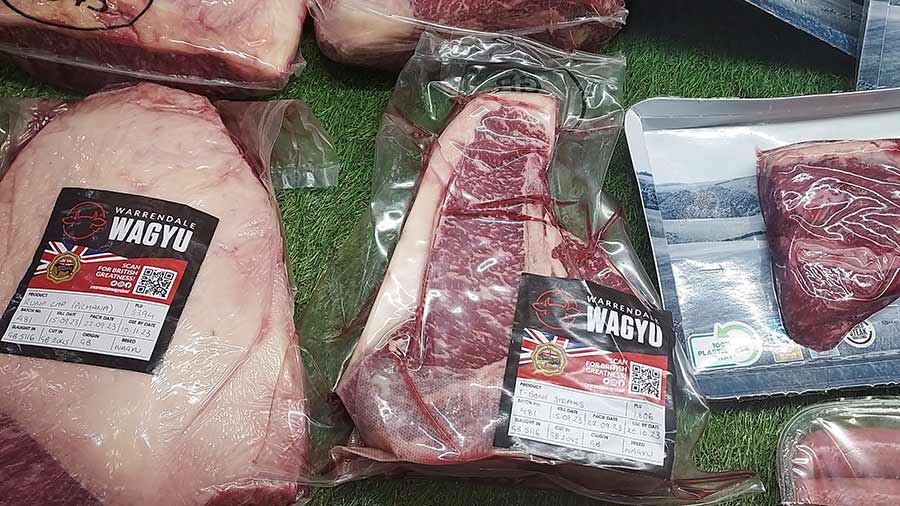 © MAG/Charlie Reeve
© MAG/Charlie Reeve One of the key results from last year’s AHDB Shape the Future consultation was that levy payers wanted to see an increased focus on improving market access and greater exports for British produce.
And that was very much the driver as the levy board hosted 13 different exporters, including Karro, Pickstock, Woodheads, and Dunbia, in the meat hall at Anuga to promote products under the British banner.
See also: New export markets offer support for UK dairy industry
The stand was a buzz of activity during the show as British exporters met with international buyers, pitched to businesses, and negotiated new deals.
AHDB director of international trade development Phil Hadley said: “Levy payers were here meeting existing customers, looking for new business, trying to balance the carcass, and selling products to those new and emerging international markets.”
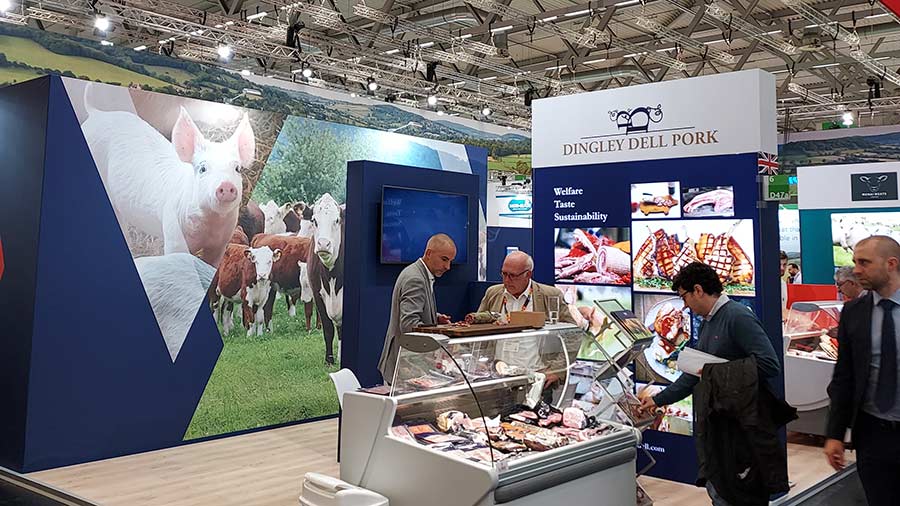
© MAG/Charlie Reeve
Market access
The UK has been really successful in improving market access in the past 10 years, according to Dr Hadley.
“We now have market access to the US for lamb, Japan for beef and lamb, and China for pork.
“We also see great opportunities in the Middle East for lamb, and growing opportunities for pork exports to the Asian market, and indeed beef and lamb in the medium and longer term.
“The US, Canada, Mexico, and Chile are also offering opportunity.”
While the UK has a strong domestic market for certain cuts, he said, export markets can also offer an outlet for high value premium products, and also for fifth quarter material, offal, and lower value cuts, which helps to balance the carcass.
Dr Hadley concluded that both processer and farmer levy payers benefit from being able to extract the maximum from each and every animal, adding value along the supply chain.
Department for Business and Trade minister Kevin Hollinrake told Farmers Weekly that, although the EU remains the UK’s biggest market for food and drink exports, the government is taking a much more international focus now – with new deals with Australia and New Zealand, the Comprehensive and Progressive Agreement for Trans-Pacific Partnership (CPTPP), and potential deals with India and the Gulf states.
Value to farmers
The value to sheep farmers of lamb exports has been calculated to represent about £35 a lamb, according to Colin Bateman, AHDB beef and lamb sector council chairman.
“Money that is taken off as levy is reinvested into industry; it comes back to farmgate in the value of the product. It’s about maintaining and increasing the value of the product sold.
“So it’s actually an investment in all of our futures rather than a straight take off,” he said.
AHDB has also estimated that exports account for about £58 of the total value of each pig in the UK.
Scottish and Welsh presence
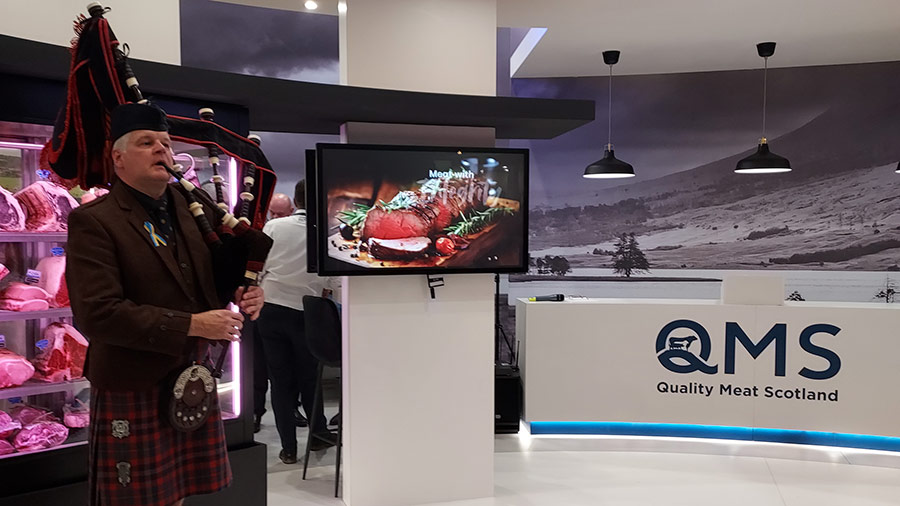
© MAG/Charlie Reeve
Quality Meat Scotland (QMS) and HCC Wales were also at Anuga, as well as Scottish rural affairs secretary Mairi Gougeon.
Mr Gougeon told Farmers Weekly that, while Scotland might not be able to compete with others in terms of quantity, it’s the quality of Scottish product that they can really promote and build on.
“We have so many opportunities that we can capitalise on to increase our exports,” she said.
“It has of course been a relatively tricky time going through Brexit and all the shocks there have been in the past few years.
“But it’s exciting to hear about all the different opportunities that our processors are making the most of, and it’s great to be here and promote our red meat industry.”
The exporters: Companies at the coalface
Cranswick
Major pork processor Cranswick, which has 22 processing sites, a throughput of 65,000 pigs a week and a turnover of more than £2bn a year, was on the stand to meet international buyers.
Louis Butler, export manager at Cranswick, said China represents about 80% of Cranswick’s fifth quarter exports.
“The diet in China is very much pork, porkmeat on the bone and pork bones for soups and broths in the winter. They produce 700 million pigs a year and they still have to import more pork,” he said.
Exports represent about £150m a year to the business, and diseases such as African swine fever (ASF) could pose a severe threat to this.
“If ASF came to the UK, the likelihood is this turnover would be wiped off, definitely from a China perspective which represents about £120m, as the UK would be suspended straight away.
For the remaining £30m to other markets, no one is going to want to deal with you,” he added.
Warrendale Wagyu
Yorkshire-based Warrendale Wagyu also exhibited at the event. Currently, the business is processing between 150 and 170 cattle a week in partnership with Dovecote Park.
It is supplied by about 700 farmers, with 250 of those being taken on in the past year. Prices paid to farmers deliver a small premium to the conventional market, and are fixed annually by the company.
Tom Richardson, Warrendale Wagyu managing director, said the business does a lot of domestic trade, but also exports to Europe.
The business focuses mainly on the retail sector, but also sells direct to consumers, supplies restaurants in the food service sector, and some product goes into the manufacturing sector to produce wagyu burgers.
Warrendale Wagyu is currently working with fellow Yorkshire business Heck sausages to produce a range of wagyu sausages.
Dairy also targeting the export market
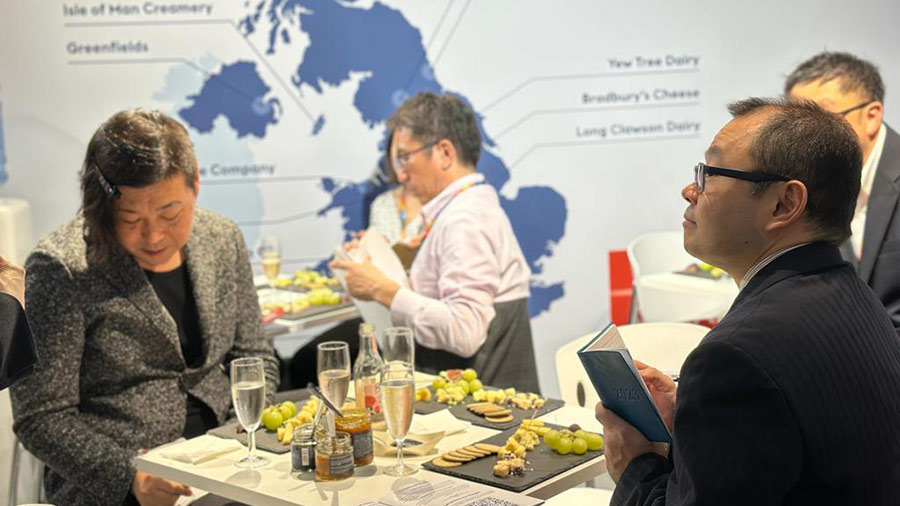
© AHDB/Dami Oyinlola
The Department for Business and Trade worked in partnership with AHDB to accommodate 14 dairy companies, including Long Clawson Dairy and Somerdale, in The British Pavilion to help promote their goods abroad.
Lucy Randolph, senior dairy exports manager at AHDB, said the stand hosted several tasting sessions for cheese buyers from a number of different countries including Japan, Brazil, and Spain.
Ms Randolph said that the levy board attending events such as Anuga helps the British dairy sector reach new markets, which in turn helps to support farmgate prices.
“The aim is to help with milk prices, to spread the risk, and ultimately sell more around the world,” she added.
A range of dairy commodities were on show, including a large variety of cheeses, milk powders, kefir, clotted cream, and butter.
Coombe Castle, which produces cheese and clotted cream, was one of the dairy exporters present.
Ben Hutchins, sales and marketing director, said clotted cream sales have been growing really fast with the biggest markets in the US, but it is also sold to Canada, Korea, Japan, the Netherlands, and Belgium.
North America accounts for about two-thirds of the business’s cheese sales, according to Mr Hutchins, with product also going to Europe, Africa, Australia, New Zealand, Japan, and Mexico.
Mr Hutchins added that Canada is a huge market for British dairy exports, but there will no longer be a trade deal in place from January onwards, unless a new post-Brexit agreement is reached.
Global competitors eye up UK market
Global competitors
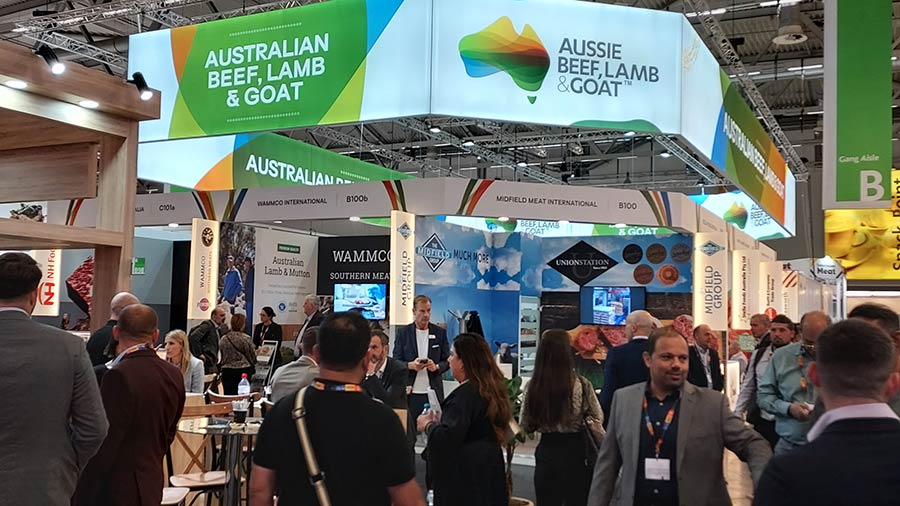
© MAG/Charlie Reeve
Many of the world’s largest beef exporters had a particularly noticeable presence at the show with vast stands representing Brazil, Paraguay, Uruguay, Canada, and Australia.
Farmers Weekly spoke to Meat and Livestock Australia (MLA) about the recent UK free-trade agreement and which markets it was targeting.
Australia exports about 75% of all the beef and lamb that it produces.
The free-trade agreement was generally viewed by farmers in Australia as a success as it would allow them to send more meat to the UK.
Stephen Edwards, MLA’s UK business manager, said boneless legs and rumps are likely to be the most common lamb cuts being shipped over. But racks of lamb may also be shipped for the food service sector.
For beef, it’s likely to be mainly grain-fed beef and wagyu beef for steakhouses that are exported to the UK.
“Food service is probably our biggest opportunity, as British supermarkets are generally very British centric with beef and lamb, but we know a lot of pub chains don’t sell or use British beef and instead use Irish or South American beef,” said Mr Edwards
Shipping takes about 40-50 days to get to the UK from Australia, he said, but economies of scale will play a role with 40ft containers full of beef cuts and five or six containers on a ship making it cheaper to export.
Out of 130,000 beef farmers in Australia only 8% are accredited to send beef to the EU, so exports are not likely to ramp up rapidly. He forecast it will be 10 years until Australia gets close to its quota.
International markets: The potential
US market
UK lamb regained market access to the US in 2022 after a ban of more than 20 years. The tariff on lamb exports is very small, so the US could provide good future potential.
It is still a tough challenge, however. According to Susana Morris, AHDB senior export manager (Americas), there are currently only two British companies able to export lamb to the US, and Australia and New Zealand are already very present.
But beef is a different story, with strong demand for British product in the US – though the quota has already been filled for this year, and additional exports face a tariff of 26.4%.
Asian market
Asia is a particularly important market for the UK because of the number of consumers present and also due to the types of products being demanded.
With pork, for example, Asia takes many of the different cuts that are not in such strong demand in the UK.
China is the major export destination for UK pork followed by the Philippines.
